by Delmar Cain – Boerne Chapter, Native Plant Society of Texas
Published in the Boerne Star on April 25, 2014
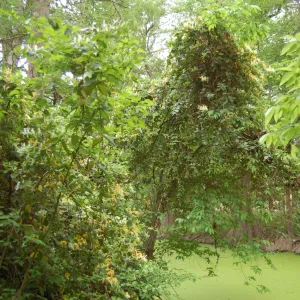
One day last week Wilt Shaw and I were following Dr. David Wagner as he hunted for moth caterpillars for a new book. Part of our path was along the banks of Cibolo Creek at the Cibolo Nature Center and at times right at the water’s edge. At this time of the year it is not unusual to catch the whiff of a blooming plant in its attempt to attract pollinators. Unfortunately, one plant that caught my attention with its pleasant fragrance was the Japanese honeysuckle (Lonicera japonica) that occupies very prominent and rapidly expanding spaces along the creek.
Even when I was in elementary school, I remember that two of the plants that we had at our home in East Texas were Japanese honeysuckle and nandina. The red berries of the nandina (now called heavenly bamboo) were a ready source of short-range, non-lethal missiles for either defense or offense in case a sister or a playmate proved irritating. Chinaberries were a step-up if heavier armaments were required. Sweetgum balls, especially the green ones, were used only if the situation was desperate and called for the really the big guns.
The Japanese honeysuckle had another use. I pulled the stamens from the fragrant flowers and thought I got a taste of something sweet when I put it in my mouth. I really did my part in spreading those three foreign, now invasive, plants in my neighborhood. Unfortunately, the native sweetgum tree never moved much farther west out of East Texas. It has beautiful fall foliage.
It seems to be ingrained in farmers, ranchers and gardeners to try something new, either from another locale or from hybrid or improved seeds. There is always a desire for greater yield, a longer lasting and prettier flower, a pest resistant species or a faster and better erosion control solution. Unfortunately at times our blurred long-range vision is unable to provide sufficient caution for our short term problem solving. And sometimes another’s problem solving may provide the seeds for another misery.
Japanese honeysuckle came to the United States in the later 1800s as an ornamental. Because it also covered areas quickly, formed a stable root system and preformed well in warmer climates, it was used for erosion control. It now is found from Maine to California and in Hawaii. It is classified as a noxious weed in some states and its sale is prohibited in some states. It is extremely difficult to remove and/or control.
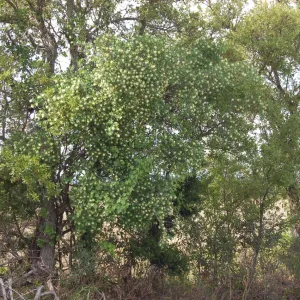
Several years ago I saw a 6-foot tall plant with beautiful pale yellow to white blooms as I drove along Kreutzberg Road. A few days later I stopped and looked at it more closely.
On examination I was struck as much by the plant’s graceful form and the beauty of its foliage as by the flowers. It was the first time that I could truly appreciate Texas honeysuckle (Lonicera albiflora) or Western white honeysuckle.
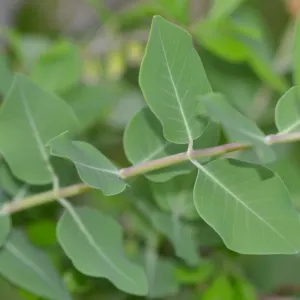
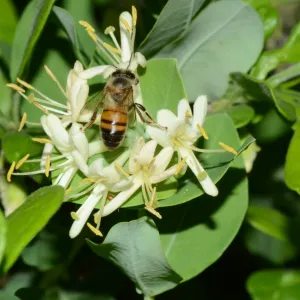
It is a perennial deciduous shrub, losing its leaves in the late fall. In the spring it grows vertical and horizontal twining branches that gently curl around nearby objects or limbs. Its leaves with smooth margins are opposite and seem to grow directly from the branch. The pale green leaves softly curl or crinkle at the margins and end with a small point. The white flowers are presented on the last leaves immediately below them. I say presented because the leaves are joined together at the base and give the appearance of holding the flowers in a saucer.
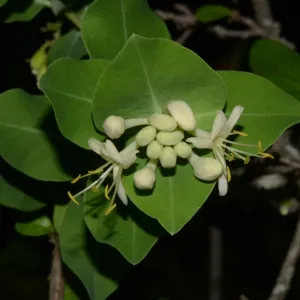
The flowers are formed in a cluster and have a most pleasant fragrance that attracts bees, including bumblebees, butterflies, and other nectaring insects After the showy white flowers fade the plant produces red berries, which are quickly eaten by birds and other wildlife. Deer will browse Texas honeysuckle if it is not protected.
A couple of weeks ago I walked by one of the small fenced areas of our yard and let out a whoop. The small plant that I had “rescued” near that large plant on Kreutzberg Road many years ago was now more than 6 feet tall and had numerous white buds that were going to open.
Texas honeysuckle grows natively in Central Texas, West Texas and in Arkansas, Oklahoma, New Mexico and Arizona. It is too bad that the northeast did not import Texas honeysuckle rather than Japanese honeysuckle. Texas honeysuckle is a good neighbor. Unlike Japanese honeysuckle, which aggressively covers its neighbors, Texas honeysuckle has a strong central stem and integrates with its neighbors. It moves slowly, as though preferring an invitation.
